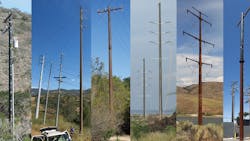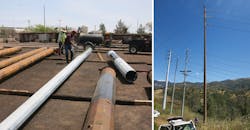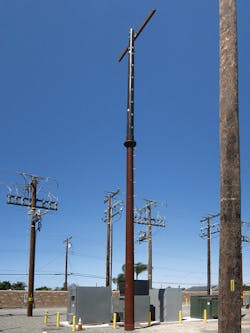Innovative Materials and Regulatory Aesthetic Requirements
The design of transmission lines and distribution circuits is challenging enough when dealing with loadings, resistance to wildfires. Now aesthetic requirements are being added by regulators. To address all of these concerns, Southern California Edison (SCE) has initiated a project to evaluate the use of alternate pole materials to meet regulatory aesthetic requirements as well as to provide increased fire resistance to its system.
Traditionally, a majority of transmission and distribution structures are made from wood and galvanized steel poles. Wood is abundant, relatively low cost and a sustainable resource. Galvanized steel poles are more specialized. They are used in select locations because they are subjected to high conductor/environmental loads, woodpecker areas and areas subject to high fire conditions. The typical areas for galvanized steel poles are in forested areas or mountainous conservation lands. In forested areas, galvanized steel poles have challenges in terms of aesthetics. It can be viewed as an unnatural feature of the environment. In certain situations, it can be viewed as a visual blight to the environment.
In the past, the general public has accepted the use of galvanized steel poles and its inherent visual impacts. However, that level of acceptance is changing. The public and, hence, government agencies are becoming more vocal in the consideration of the aesthetics of steel poles. In Southern California, for example, government agencies are starting to require that SCE consider visual aesthetics before granting approval for projects. They want to ensure that the poles would blend into the existing natural environment. In most instances, they are requesting that SCE either make its steel poles look like the more natural-looking wood poles or consider alternative pole materials.
To address these concerns, SCE has evaluated other pole material types. In the evaluation, SCE performed a detailed review of the materials prior to approving their use on the SCE system. The evaluation ensures that only high-quality products from reputable suppliers are used.
Evaluating Materials
SCE has a thorough vetting process in the evaluation of new products and materials for use on its system. The process includes not only a technical review of the pole products, but also a review of the manufacturer’s history, work environment and financial stability. SCE evaluates several technical areas for poles. These include strength testing, which covers ultimate strength of product; load vs. deflection curves, and equivalent wood pole class.
In addition, SCE evaluates pole performance under various environmental conditions (accelerated age testing, UV testing, water intrusion testing, exposure to corrosive environments, and fire resistance). SCE also evaluates the pole’s assembly and installation, which includes manufacturer recommended instructions and how the pole integrates with SCE work methods.
Because pole materials will be used in high-fire areas, simulated wildfire testing of the pole materials is a key component in the evaluation process. The purpose of the fire testing is to determine the magnitude of a pole’s loss of strength when exposed to a wildfire. Two fire testing methods have been adopted by SCE in this evaluation. These are the “ASTM Standard Test Method for Determination of Charring Depth of Wood Utility Poles Exposed to Simulated Wildfire Conditions (Draft)” and the RS Poles Fire Test Procedure.
In its effort to find options which can be used in aesthetically sensitive areas, SCE has looked at many different alternatives. There is no one alternative which is good for all situations. Each alternative has its advantages and disadvantages. A discussion of these alternatives follows.
FRP Poles
Fiber reinforced polymer (FRP) poles have the advantage of being colored to natural earth tones. Since the color is achieved by pigments in the resins, the color of the poles can be changed by design. FRP poles are inert and will not harm the environment. They are resistant to attack from insects, woodpeckers and other wildlife. They have a higher resistance to fires than wood poles. For a given pole class, FRP poles are generally lighter and stronger than wood poles.
SCE has evaluated multi-sectional poles manufactured by RS Technologies (RS) and Highland Composites as well as single-piece poles manufactured by Creative Pultrusions and Shakespeare. Multi-sectional poles have the advantage of being easier to transport and install in locations with tight clearances, as each section can be carried in and the pole assembled onsite either on the ground or vertically by use of gins.
When exposed to fire, FRP poles will ignite, however, they will self-extinguish when the heat source is removed. SCE has worked with FRP pole manufacturers to define the fire resistance of their poles and the residual strengths after being exposed to fires. Highland and RS are increasing the fire resistance of their poles by developing fire resistant products that can be applied to the surface of their poles.
Highland is developing a fire-resistant coating that will be applied by spray or brush. RS has developed an FRP fire shield that is wrapped around its poles. In the RS fire tests, temperatures between 1,470º (800º C) F and 1,830º F (1,000º C) were applied to the pole for a duration of three minutes. After the test, the fire shield was essentially destroyed, however, in a subsequent load test, the pole broke at its typical, mean, ultimate failure load.
Ductile Iron Poles
SCE has evaluated the use of ductile iron poles in environmentally and aesthetically sensitive areas. Ductile iron poles are fabricated in a spun casting process where molten material is placed in a cylindrical mold and spun until the molten material cools and solidifies. After extraction from the mold, the pole has a dark gray surface, however, when it is installed and exposed to the natural environment, the surface of the pole develops a reddish-brown colored patina. This patina protects the base metal from corrosion and helps blend the pole into the natural environment. While a ductile iron pole has less deflection than an equivalent wood pole, they are heavier. Since the pole is conductive, pole grounding will need to be considered.
Ductile iron poles are inherently fire resistant, however, there was concern that the metallurgical structure of the material could change when exposed to fire, potentially weakening the strength of the pole. To address this concern, a ductile iron pole was fire tested to the draft ASTM Wood Pole Standard. After the fire test, a metallurgical analysis was performed. The analysis revealed that no significant changes were seen in the metallurgical composition of the pole and that the strength of the pole had not been compromised.
Natina Surface Treatment
Natina is a surface treatment that can be applied to the surfaces of galvanized steel poles to give the poles a brown to dark gray finish that would blend the poles into the natural environment. The advantage with using Natina is that existing SCE galvanized steel pole designs could be used in aesthetically sensitive areas without having to consider the use of alternate pole materials. It is also the only alternative that can be used on existing in-service poles.
Natina is a weak acid solution that reacts with the galvanizing on a pole to form a dark color. The solution can be sprayed or brushed onto the surface of a pole. It is then allowed to cure. The length of the curing time is dependent on heat. The hotter the environment the pole is in, the quicker the curing process. The final color can range from a light brown color to a dark gray color. The color depends on a number of factors including concentration of Natina, the number of coats of Natina, the heat of the environment, the finish of the pole and the chemical composition of the galvanizing. The coating is thin, which may require retreatment in the future.
Natina was used on a group of galvanized tubular steel poles in the hills above Goleta, California, U.S. These poles are in the view plane of an environmentally active community. The community encouraged SCE to reduce the aesthetic impacts of these poles. Because these poles were in service, SCE decided to treat these poles with Natina. Natina reduced the aesthetic impacts of the poles to the degree that the community was satisfied with the result.
Concrete Poles
SCE has considered the use of concrete poles in aesthetically sensitive areas. Concrete poles can be statically cast or spun cast. The aesthetics of a concrete pole can be achieved either through color by the use of pigments in the concrete or by the finish of the pole. An exposed aggregate finish can blend the concrete pole into the architectural environment in an urbanized setting.
Concrete poles are inherently fire resistant. They have less deflection than an equivalent classed wood pole. However, they are heavier than an equivalent classed wood pole, thus, pole locations will have to have vehicular access and heavy equipment may be required to set larger poles.
Weathering Steel Poles
Weathering steel poles are formed by press breaking a sheet of steel into either a round or polygon shape. Typically, two half shells are formed, which are then seam welded together. The naturally forming reddish patina develops quickly when exposed to the environment and make the poles ideal for aesthetically sensitive forested areas. While long service lives should be achieved in most areas, there are areas where weathering steel poles should not be used, such as coastal or highly industrialized areas.
Weathering steel poles are inherently fire-resistant as verified by SCE fire testing. They have less deflection than an equivalent classed wood pole. The disadvantages of weathering steel poles are that only one color can be achieved, the patina on the pole can leech and stain the area around the base of the pole, and pole grounding will need to be considered.
Hybrid Poles
SCE has worked with a pole supplier to develop a hybrid pole. This pole consists of a weathering steel base with an FRP top section. The advantage of this pole is that the base section provides a high level of fire resistance while the FRP top section provides an insulating section between the energized conductors and the ground. The disadvantages are that they are more expensive than a single material pole, it is difficult to precisely match the colors of the FRP top with the weathering steel base and the patina on the pole can leech and stain the area around the base of the pole.
No One Alternative
As a result of government and public concerns regarding the aesthetics of its poles, SCE has explored alternate pole materials and coatings that can be used to address the public’s concerns while maintaining the required strengths and increasing the reliability of its lines under natural environmental conditions. There is no one alternative that is good for all situations; each alternative has its advantages. A utility needs to look at the site and load conditions of a particular structure location to select the best alternative to use.
While SCE currently uses alternate pole materials in aesthetically sensitive areas, this effort is an evolutionary process as SCE continues to look at new pole materials that will provide it with increased reliability while minimizing aesthetic impacts. In addition to looking at new materials, SCE is working with its suppliers to develop new innovative designs that will meet those same.
About the Author
Clinton Y. Char
Clinton Y. Char is the manager of the Transmission Engineering, Structural Analysis group at the Southern California Edison, Co. He has BS and MS degrees in civil engineering and is a registered professional engineer with more than 28 years of transmission and distribution experience. He is a member of ASCE and is currently involved with four ASCE task committees. He has made numerous conference presentations and has published 18 technical papers.







